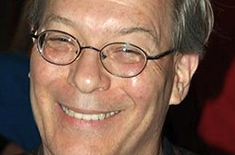Celebrated U Computer Graphics Alumnus Passes Away
August 30, 2017

Lance J. Williams, a University of Utah computer science student during the department’s famed period in computer graphics development in the early 1970s and the inventor of computer image optimization known as mip-mapping, died Aug. 20 of cancer. Williams, who was 67, was living in Los Angeles, according to his Facebook page.
Williams attended graduate school at the U’s then computer science department from 1972 to 1976 along with other department luminaries at the time including Pixar founder Ed Catmull and Netscape founder Jim Clark. He stood out even among these exceptionally capable graduate students. A true Renaisssance man, Williams was a computer science student who already gained recognition for his poetry and artwork.
“Lance Williams was a great and irreplaceable friend for over thirty years. He was an outstanding source of new ideas, interdisciplinary pointers and unusual insights. And he was a key computer graphics pioneer, of course, honored by the Academy of Motion Picture Arts and Sciences for his many contributions to computer animation and film.
But he was also unusually talented in literature, in music and had a wonderful drawing and sketching ability. He had even been a Five State Intercollegiate Chess Champion.He was kind and thoughtful, helpful to students, generous with his time, and sincere in his efforts. He was remarkably creative and skilled in many different ways, always armed with a wry sense of humor and a penetrating intellect.
It’s rare for all of this creative talent and ability to have been so concentrated in just one person. You never quite knew ahead of time what he might come up with, or suggest, as a new idea.
He was a great and respected friend, as well as being a pioneering computer graphics researcher who had world-wide impact. He will be sorely missed by many people.”
– Professor Al Barr, California Institute of Technology
Lance would make major contributions to graphics, with numerous research papers, three of which would lead to his thesis and a doctorate in computer science from the U in 2000.

A legend in the field of computer graphics, he is best known for inventing texture mip-mapping (demonstrated in his picture to the right), shadow mapping, and image-based rendering, processes used today that allow computerized images to be optimized for better rendering speed and improved picture quality.
During his career, Williams worked in both television and film as well as for companies Apple, Disney, Google, Nokia, and the movie special effects group DreamQuest. He also worked with famed Muppets creator Jim Henson and for Hollywood studio DreamWorks SKG as the head of long-term software development where he worked on such animated films as “The Prince of Egypt,” “The Road to El Dorado,” and “Spirit.” He later received an Academy Award in 2002 for his work in computer animated graphics and special effects and the ACM SIGGRAPH Coons Award in 2001 for his contributions to computer graphics.
“Lance’s subsequent spectacular career was clearly foretold early in his graduate study, for he exhibited all the prerequisite qualities,” said U computer science professor Rich Riesenfeld. “Namely, he was passionately and tenaciously motivated to establish himself in computer graphics, extraordinarily original and resourceful in his thinking, and prodigiously and broadly talented. And, all of these attributes were embodied in a profoundly humanistic spirit. It was a privilege to be Lance’s thesis advisor and then lifelong friend.”
In 2012, Williams joined Nvidia Corp. as a researcher for the company’s VR and face-tracking groups where he worked until his passing.
“Those who knew him will remember most his unfailingly polite manner; his gentle, erudite, and wickedly funny sense of humor; his incredibly creative insights on technological problems; and his seemingly encyclopedic knowledge of science, engineering, history, and art,” a co-worker wrote on Nvidia’s website. “His brilliant, creative mind will be sorely missed.”